Born in Japan, educated in the United States (Massachusetts Institute of Technology, MIT) and after a period as artist-in-residence at the Kunsthochschule für Medien (KHM) in Cologne, now working for some years in Europe (Holland): Atsushi Ogata, a cultural mix. In his work nature and culture become one and demonstrate the concept of 'being human' in a universal context. His videos are characterized by a shadowy language of imagery and strong poetic eloquence. Important for Ogata's development was the discovery that he could use the camera like a paint brush; that he could paint with video, treat his shots like strokes of paint. With his earlier mainly nonverbal videos and installations the artist tries to stimulate our senses and evoke a totally esthetic sometimes almost meditative experience from the viewer. Most of his work over the past years has been shot with the same pictorial/visual technique, always balanced between an abstract and a figurative level. The thread running through his work is then more of a stylistic nature rather than thematically determined. Ogata communicates a mood, an atmosphere, a connection people have with their environment. "In a certain sense what I record with the camera is not as important as how I record it and what kind of mood I'm trying to capture", says Ogata. "It is about reaching a certain level of consciousness when I'm filming; that I have an unconsciousness connection with my surroundings and am almost one with what I'm filming." This is the experience Ogata tries to bring across to the viewer rather than a definite message about a certain subject. The images in his works, although stemming from reality, are often hazy and blurred. As smudges and spots, the passing figures catch the viewer's attention. To be sure Ogata's work has a realistic footing, but he leaves the perception of his images to the viewer's fantasy and powers of association. "I only want to show a bit of reality. If the image is always sharp and clear, nothing is left to the imagination." This is his way of arousing the viewer's attention. In his latest installation, which involves three monitors placed next to each other, three principle characters – a police officer, a dancer and a child – are on the move in an Amsterdam urban setting. On their journey through the city they are followed by a hand-held camera which is recording them from an unusually low position. This gives us a totally different cityscape than that from the more common eye-level recording. To give the figures an abstract quality all three are dressed in black, giving them the form of a dark silhouette. Ogata used a slow shutter speed for the filming. When the camera or what is being filmed moves fast, the image blurs and becomes an abstract pattern, while the image becomes more realistic as the movements slow down again. These continue to shift between figurative and non-figurative creating a kind of tension that Ogata finds interesting. In New York he saw a Mondriaan retrospective and the transition in those paintings of the purely figurative to the totally abstract. A tree with leaves gradually changing into a design of lines and form. Ogata: "It is more challenging to be able to see things in different ways. Art should give rise to questions not just give answers." The images of the three figures are seen in continual change on the three monitors, accompanied by various street noises which were recorded during the journey through the city. The positioning of the work and the images connect the internal and external worlds. Personal feelings can be evoked when the viewer is reminded of locations and experiences in the city.
– Marieke van Hal |
With: Muus Jongedijk, Ingeborg Houwen, Jan de Jong
Technical assistant: Dan Oki Productions
Thanks to: NOB Nieuwe Media Services
Production: World Wide Video Festival/Melkweg
Atsushi Ogata, 1962, Kobe (Japan)
Lives and works in Amsterdam (Netherlands)
|
|
